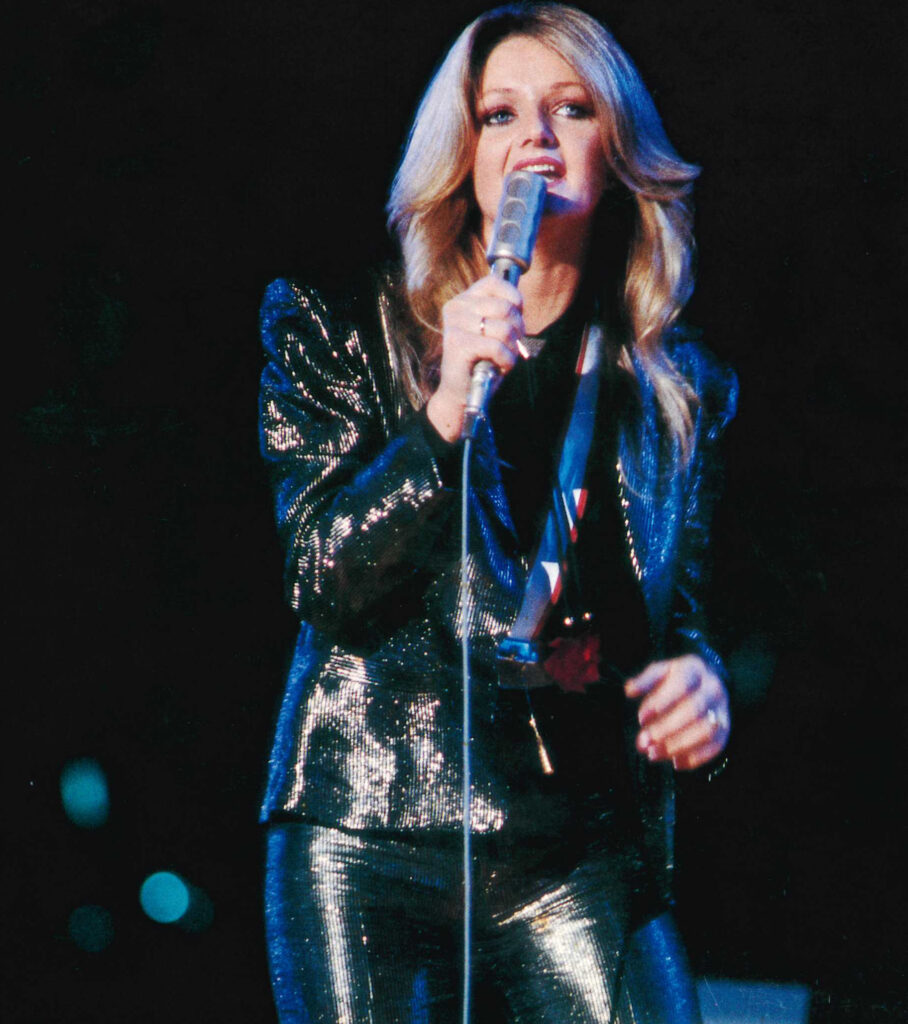
Celebrating 40 Years of ‘Goodbye to the Island’
28 January 1981 – Bonnie Tyler releases her fourth studio album, Goodbye to the Island.
Bonnie’s recording career began under RCA Records in 1976. With her songwriting managers, Ronnie Scott and Steve Wolfe, she enjoyed hits with “Lost in France” and “It’s a Heartache”. By the end of the 70s, Bonnie had released three country-pop oriented albums. With her fourth, she wanted more control over the choice of songs.
Recording sessions began in the summer of 1979 and continued well into 1980. Goodbye to the Island strikes a dramatic shift in tone from the previous record, Diamond Cut, which they had aimed at the Nashville country market.
Scott and Wolfe entered one of their new compositions, ‘Sitting On the Edge of the Ocean‘, in the Yamaha World Popular Song Festival, an annual music festival held at the Nippon Budokan Hall in Tokyo.
“Music is the universal language of mankind,” wrote Genichi Kawakami, president of the Yamaha Music Foundation. “Knowing no political and economic boundaries, the joys of music form an immediate bond between people everywhere, and this international festival is dedicated to that spirit.” The festival had been running since 1970, with yearly entries from a variety of countries including Norway, Mexico, Jamaica, France, Israel, the UK, and the USA.
Bonnie’s top competitor was Cissy Houston, who represented the United States with ‘You’re the Fire’. She brought her sixteen-year-old daughter, Whitney, to the festival. “She asked me for my autograph,” Bonnie remembers. “She was a young little sweet thing!”

Bonnie’s performance of ‘Sitting On the Edge of the Ocean’ earned her the Grand Prix award, which included a certificate, gold medal and $5,000 cash. Her success at the festival led to Bonnie’s first appearance on the Japanese charts, with a new compilation The Best of Bonnie Tyler reaching no. 65 on the Oricon LP Chart. The song itself became so popular in Japan that many local singers recorded their own versions, including Yuki Katsuragi, whose cover received extensive radio airplay.
Bonnie also recorded a Spanish version of the song, titled ‘Sola A La Orilla Del Mar’, released exclusively in Argentina. The lyrics were translated by Buddy and Mary McCluskey, an Argentinian singing couple noted for their Spanish translations of ABBA lyrics in the early 80s.
“It was the happiest moment of my life so far,” Bonnie beamed to Shigeru Wakabayashi, a Japanese journalist, following her concert at the Korakuen Hall. This was a crucial moment in Bonnie’s career as she had began exercising more control over her recording material. “I’m not satisfied with the records I’ve put out so far. Some people think of me as a country singer, but pop-rock is the kind of music I want to make.” She mentioned her upcoming album, which at the time was due for release in 1980. “I’m really happy with how the recording turned out. As you could tell from the concert, it’s really exciting,” she said, citing her performances of Procol Harum’s ‘A Whiter Shade of Pale’ and Bad Company’s ‘Oh Atlanta’.
While Bonnie was still touring, RCA released ‘I Believe in Your Sweet Love’ as a teaser for the new album. “I’m a sucker for anything with a jangling guitar and this has plenty of that,” wrote Record Mirror journalist, Daniela Soava, who nominated the track as one of her singles of the week. “In fact, it sounds like the intro to a spaghetti western from the cowboy’s side. I bet this would sound great cruising down the dust track on your trusty steed.”
When the new decade arrived, it was decided that the album tracks needed re-recording. They brought in a team of long-time Gerry Rafferty collaborators including “Baker Street” saxophonist Raphael Ravenscroft, guitarist Gary Taylor, keys player Betsy Cook, and her soon-to-be husband and producer, Hugh Murphy. The recording experience was like nothing Bonnie had done before. They rented a couple of villas off the coast in Vilamoura, Portugal. One villa was for living in, and the other was filled with recording gear taken from the RAK Mobile recording facility.
“It was like an articulated truck,” bass player Kevin Dunne remembers. “We were set up in a villa, separate to where we were all staying, with the truck outside. It contained the desk, the recording gear, and the mixing desk. They took the tapes back to RAK Studios in St. John’s Wood, and mixed them.”
The beautiful summer weather made for a more pleasant experience than previous recording sessions. “Everyone was in a good mood all the time”, Bonnie told Dutch magazine OOR. “In England, you’re usually recording with people who act like they’ve heard enough music for one day. If I think about it carefully, it was actually even more difficult to record in Portugal. The warmth is great when you’re free to do what you like, but when you’re recording it’s not quite so pleasant. But you could come out of the studio, all hot and sweaty, and dive into the Mediterranean. That was wonderful.”
The first result of these recording sessions appeared in September 1980 with the release of ‘I’m Just a Woman’, a bluesy Scott and Wolfe track that allowed Bonnie to channel her Janis Joplin influences. The title track was issued in December 1980, a month ahead of the album itself.
The total number of Ronnie and Steve songs were cut down to just five on Goodbye to the Island, with Bonnie also recording cover versions of Procol Harum’s ‘A Whiter Shade of Pale’, Dan Hill’s ‘Sometimes When We Touch’, and the country and western classic ‘The Wild Side of Life’. Then little-known Chris Rea wrote ‘The Closer You Get’, and a version of Ian Sutherland’s ‘Wild Love’ offers Bonnie’s finest vocal performance on the album.
“I know I can’t match the original version of ‘Whiter Shade of Pale’,” Bonnie confessed, “But I still wanted to record it. It’s a very unusual song to sing. It means something to a lot of people. Procol Harum’s version came out in the mid-60s at a time when people were calling out to love one another. Do you remember, flower power and all that? I tried to capture that feeling again.”
Goodbye to the Island is available as part of the recent box set The RCA Years. Buy it at cherryred.co.uk
The Musicians
Engineered by Steve Lipson, Greg Jackman and Doug Hopkins
Produced by Hugh Murphy for Soundbarrier Ltd
Produced by Hugh Murphy, Ronnie Scott and Steve Wolfe for Soundbarrier Ltd
Recorded in Vliamoura, Algarve, Portugal on the RAK Mobile, at Startling Studios, Berkshire, and mixed at Ridge Farm Studios, Surrey
Special arrangements by Betsy Cook, John Cameron, Mike McNaught and Wil Malone
Guitar solos by Garth Watt-Ray
Sax by Raphael Ravenscroft
Keyboards by Betsy Cook and Mike McNaught
Bass by Kevin Dunne and Felix Kirsch
Drums by Jeff Allen and Liam Genockey
Rhythm guitar by Steve Lipson, Gary Taylor and Robert Ahwai
Design & art direction by Andrew Christian
Photography by Chris Thomson

